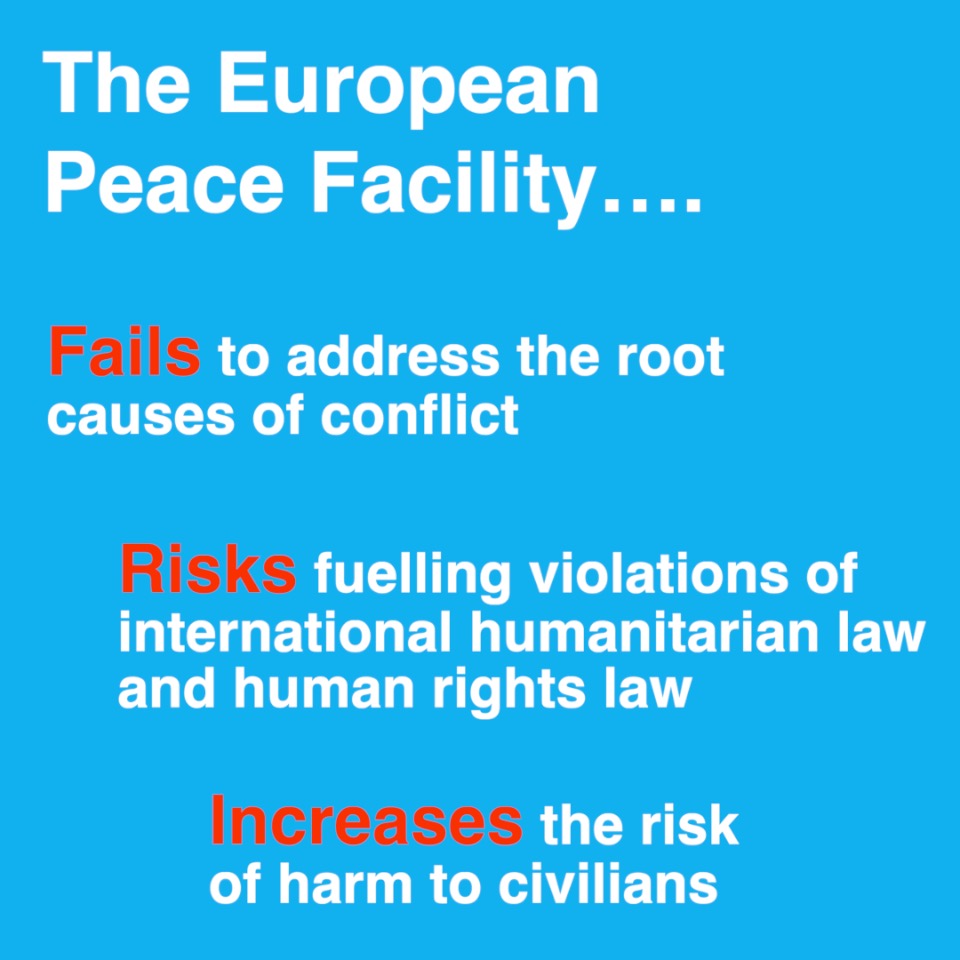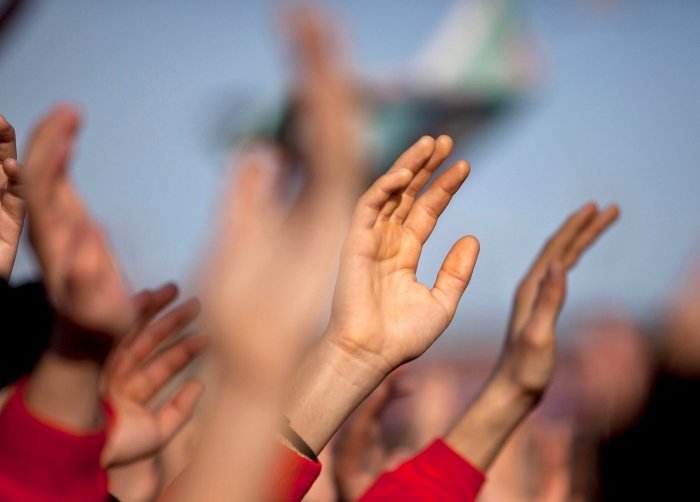Joint Statement: European Peace Facility: Causing harm or bringing peace?
The NHC, together with 39 other civil society organisations, signed a statement warning the European Union it risks fuelling conflict and human rights abuses around the world if it adopts the European Peace Facility (EPF) in its current form.
Currently, the €5 billion EPF is designed to fund EU-branded initiatives to train and equip foreign military and security forces, including the possibility of providing them with lethal weapons.
“The proposed European Peace Facility not only fails to address the root causes of conflict, it also risks harming civilians and fuelling violations of international humanitarian law and international human rights law.” – Drissa Traoré, Coordinator of the Joint Office of FIDH and AMDH (Association Malienne des Droits de l’Homme) in Mali.
Together with 39 other civil society organisations , the NHC calls on EU Member States to:
- strengthen conflict prevention and civilian harm prevention and mitigation,
- exclude the transfer of lethal weapons from the proposal, and
- adopt a due diligence framework to ensure the facility’s activities are conducted in accordance with international law.
“It is paramount that the EU and its member states ensure that EPF-funded programmes do not escalate conflict but rather contribute to long-term peace.” – Olivier Guiryanan, Executive Director of BUCOFORE in Chad.
Click here or read on for the full statement.

European ‘Peace’ Facility: Causing harm or bringing peace?
Joint Civil Society Statement
November 2020
EU Member States are currently negotiating a new financial instrument that would introduce fundamental changes to EU foreign policy. If passed in its current form, the €5bn European Peace Facility (EPF) would finance EU-backed military operations and activities abroad, including the possibility to train and equip with lethal weapons foreign military and security forces under the EU flag. By creating this new off-budget facility, Member States are circumventing the EU treaties under which the EU budget cannot be used for the provision of arms(1). They also place the EU in a position to adopt more military approaches to supporting certain governments, including in terms of training, equipping, and ‘mentoring’ local military and security forces.
The undersigned civil society organisations warn that the proposed facility not only fails to address the root causes of conflict, but also risks fuelling violations of international humanitarian law (IHL) and international human rights law (IHRL), while increasing the risk of harm to civilians overall.
If EU Member States do go ahead in adopting the EPF, they must improve conflict prevention and civilian harm prevention and mitigation(1.); exclude the transfer of lethal weapons from the proposal (2.); and adopt a due diligence framework to ensure the facilities’ activities are conducted in accordance with international law (3.).
1. Preventing conflict and mitigating civilian harm
The proposed EPF lacks the features to meaningfully support its objective to prevent conflict and preserve peace. Evidence from the recent past shows that the military and security assistance measures foreseen to be funded by the EPF are likely to contribute to the escalation of conflict, in particular in fragile and conflict-affected settings. In contexts such as Afghanistan, Somalia and the(2,3) Sahel(4), international interventions (directly or through support relationships with (local forces) to counter terrorism and neutralise armed groups have fuelled further violence, strengthened repressive regimes, enabled armed groups to grow and thrive, failed to protect civilians and increased community tensions(5). In order to avoid this pitfall, the European Union and its member states need to focus on ensuring programmes address and do not exacerbate conflict drivers, and strengthen partners’ abilities to protect and support civilians. The operational effectiveness and capacity to meet political objectives of long-term peace and stability will directly depend on their efficacy in avoiding civilian harm, addressing drivers of conflict and fostering human security.
In order to prevent and mitigate civilian harm, the EU and its Member States must adopt internal safeguards to ensure that all activities conducted under the EPF are conditional on conflict sensitivity assessments, Civilian Harm Mitigation assessment frameworks, and PoC (Protection of Civilians) capabilities assessments of local forces. Furthermore, civilian harm mitigation measures
should be included in all technical support offered to local forces, including to the planning, conduct and review of military operations; and training programmes should introduce a practical approach to risk reduction and mitigation. EPF funded military assistance actions should also systematically include civilian harm tracking (CHT) mechanisms, and civilian complaints mechanisms by partner forces, in order to strengthen the EPF’s accountability to the local population, and strengthen the EU’s ability to detect, investigate, and mitigate issues.
2. Excluding the transfer of lethal weapons through the EPF
The type of weapons most likely to be transferred under the new instrument – including small arms, light weapons and ammunition – are also at greatest risk of misuse and diversion(6). In the Sahel region, where the EPF is likely to be used, non-state armed groups increasingly get their weapons from national security forces through looting(7), black markets(8) or simply by being equipped by the national security forces(9). In many conflict-affected contexts, the EU is currently
unable to monitor what happens to the equipment it provides after it is handed over to partner governments and security forces. Allowing arms transfers through the EPF would contradict the EU’s disarmament efforts, as well as global initiatives such as the African Union’s Silencing the Guns campaign.(10)
Moreover, the EPF is set to rely only on the current EU arms exports legal framework for the compliance of arms transfers with international law(11). Under these rules, Member States have the obligation to deny arms export licences when there is a risk that the arms to be supplied will be used for human rights violations. Civil society organisations across Europe have documented systematic failures in the implementation of this rule(12), resulting in frequent transfers of European arms to repressive regimes such as Egypt or Saudi Arabia.
Relying solely on these rules in the context of the EPF is therefore clearly insufficient and will likely result in further arms transfers without ensuring respect for EU law and Member States’ human rights obligations. Without effective measures to ensure these rules are enforced (including enhancing transparency and setting up alert/early warning mechanisms), and considering the high risk carried by arms transfers, the possibility to provide lethal weapons must therefore be excluded from the EPF.(13)
3. Developing a due diligence framework
Beyond the issue of equipment, the proposal fails to include appropriate safeguards to mitigate civilian harm and prevent IHRL and IHL violations that may arise or be eased as a result of assistance measures. In environments such as the Sahel, such violations have been widely documented by civil society organisations(14) and UN bodies. (15) The development of a mandatory due diligence framework, including the conduct of a risk assessment and the set-up of mitigating measures, would be a first step towards improving the protection of civilians and addressing and preventing IHL and IHRL violations and misuse of EPF assistance measures.
This framework should require the conduct of a robust and continuous risk assessment by an independent and impartial body, in partnership with local and international civil society organisations, before any funding support decision is taken and throughout the programme cycle. These reports should be publically available to ensure transparency and accountability. If risks are identified, including the risk that violations of international human rights law, international humanitarian law and international refugee law may be committed in association with the assistance funded, this framework should lead to a decision to limit or not fund support.
Robust internal reporting and monitoring procedures should be established within the EPF and conducted in partnership with local communities and civil society. These procedures should also include rapid suspension or limitation mechanisms based on previously defined conditions and procedures whereby the EU and Member States have the obligation to immediately suspend the assistance measure and seek to retrieve all supplied equipment from the recipient in case of related human rights violations or diversion of equipment. In order for such due diligence framework to be effective, it must be combined with an independent complaint mechanism(16), providing affected citizens and local stakeholders with effective recourse to remedy for violations committed under the facility. In any case, it is necessary to explicitly establish legal co-responsibility of Member States and the EU in ensuring the EPF’s activities are conducted in accordance with international law. Both the EU and Member States are called to intervene at different stages of a complex decision-making process, which is likely to create confusion when it comes to determining which actor bears responsibility for the actions undertaken and activities decided under the facility. The complaint mechanism should also be able to issue specific recommendations with regard to suspension of arms sales based on Common Position criteria and the Arms Trade Treaty.
It is also of utmost importance for the EU to meaningfully engage with local communities and civil society at all stages of the process, including in the identification of needs, planning, conduct and action review of assistance. As key contributors to peace, the involvement of human rights defenders and women’s rights organisations(17) in conflict-affected countries must be ensured;
their work should be supported through sustainable funding programmes with robust human rights, democracy and rule of law components. Such engagement with communities is essential for the EU to contribute to peacebuilding and to provide non-military responses to conflict and crisis, including through effective arms control and disarmament initiatives.
As it stands, the EPF risks feeding into the very dynamics it seeks to break. If leaders insist on taking these discussions forward, they must ensure these significant shortcomings are urgently addressed and EU Member States use this opportunity to make a positive
contribution to peace and human rights.
Full list of signatories:
AGdF
ALQST
AMDH (Association Malienne des Droits de l’Homme)
ANDDH (Association Nigérienne de Défense des Droits de l’Homme)
Brot für die Welt
Bucofore
CIVIC (Centre for Civilians in Conflict)
Christian Aid
Church and Peace – Europäisches friedenskirchliche Netzwerk
CIHRS (Cairo Institute for Human Rights Studies)
Concordis International
Cordaid
EIRENE
EurAc
FIDH (International Federation for Human Rights)
Forum Civil Peace Service (Forum ZFD)
German Platform for Peaceful Conflict Management
Greenpeace
International Fellowship of Reconciliation Austria
Iraqi Civil Society Initiative
Lliga dels Drets dels Pobles
MBDHP (Mouvement Burkinabe des Droits de l’Homme et des Peuples)
Netherlands Helsinki Committee
ÖNZ (Ökumenisches Netz Zentralafrika)
OSEPI (Open Society European Policy Institue)
Oxfam
PAX
Pax Christi International
Pax Christi Flanders
Peace Union of Finland
Plan International EU Office
Saferworld
Shadow World Investigations
Stop Fuelling War
Swedish Peace and Arbitration Society
The Life & Peace Institute
Un Ponte Per
Vredesactie
Women’s International League for Peace and Freedom (WILPF) Sweden
World Vision
- Article. 41(2) of the Treaty on the European Union prohibits the use of the EU budget for “such 1
expenditure arising from operations having military or defence implications” and thereby excludes the transfer of weapons through EU budget. - See: Saferworld “Hammering the bread and the nail”: lessons from counter-terror, stabilisation and statebuilding in Afghanistan, Jan. 2016: https://www.saferworld.org.uk/resources/publications/1031
- See: Saferworld “Barbed wire on our heads”: lessons from counter-terror, stabilisation and statebuilding in Somalia, Feb 2016: https://www.saferworld.org.uk/resources/publications/1032-
barbed-wire-on-our-heads; Saferworld, Counter-terror and the logic of violence in Somalia’s civil war: time for a new approach, Nov 2018: https://www.saferworld.org.uk/resources/publications/1191-
counter-terror-and-the-logic-of-violence-in-somaliaas-civil-war-time-for-a-new-approach - See: Tull, D., Rebuilding Mali’s army: the dissonant relationship between Mali and its international partners, 1 March 2019: https://academic-oup-com.eres.qnl.qa/ia/article-abstract/95/2/405/5315698?
=redirectedFrom=fulltext ; Guiryanan, O., Counterterrorism assistance to Chad for the Sahel: The Price the People Pay, 2 September 2020: https://www.justsecurity.org/72199/counterterrorism-assistance-tochad-for-the-sahel-the-price-the-people-pay/ - Research shows that these risks are particularly heightened when providing countries engage in geopolitical competition between each other. See: RAND Corporation, Building Security in Africa, An Evaluation of US Security Sector Assistance in Africa from the Cold War to the Present, 2018: https:// www.rand.org/pubs/research_reports/RR2447.html
- See: TRESA, Small Arms and Light Weapons (SALW) Transfer Conrol, 2006: http://www.poa-iss.org/TMD/Upload/1_SALW%20Transfer%20Controls%20TRAINEE.pdf
- See: Koné, H., Where do Sahel terrorists get their heavy weapons?, ISS Today, 12 February 2020: https://issafrica.org/iss-today/where-do-sahel-terrorists-get-their-heavy-weapons
- See: Small Arms Survey, Probing the grey area, irresponsible arms transfers, 2007: http://www.smallarmssurvey.org/fileadmin/docs/A-Yearbook/2007/en/full/Small-Arms-Survey-2007- Chapter-03-EN.pdf
- See: Safi, M., “Guardians of the bush”: brutal vigilantes police Burkina Faso, The Guardian, 13 July 2020: https://www.theguardian.com/world/2020/jul/13/guardians-of-the-bush-brutal-vigilantespolicing-burkina-faso-islamist-militants-ethnic-conflict
- See: 2020 Silencing the guns: Creating Conditions for Africa’s Development, https://au.int/en/flagships/silencing-guns-2020
- The two main elements of the current framework are Common Position 2008/944/CFSP of 8 December 2008 defining common rules governing control of exports of military technology and equipment (https://eur-lex.europa.eu/legal-content/EN/TXT/PDF/?uri=CELEX:32008E0944&from=EN) and the Arms Trade Treaty (https://thearmstradetreaty.org/treaty-text.html?templateId=209884)
- See FIDH Report, Egypt: a repression made in France, 2 July 2018: https://www.fidh.org/en/issues/litigation/egypt-a-repression-made-in-france; Observatoire des armes wallonnes, Rapport de l’observatoire des armes wallonnes, 3ème édition, 26 May 2020 [in French]: https://www.liguedh.be/wpcontent/uploads/2020/09/observatoire_des_armes_wallonnes_-_3e_me_e_dition.pdf
- Categories ML1-4 and ML6-10 of the EU Common Military List (https://eurlex.europa.eu/legal-content/EN/TXT/?uri=OJ%3AJOC_2019_095_R_0001) must be excluded altogether due to their high risk of diversion and misuse. However, most types of equipment in the list can do significant harm when misused.
- See FIDH Report, Central Mali: Populations caught between terrorism and anti-terrorism, 20 November 2018: https://www.fidh.org/en/region/Africa/mali/central-mali-populations-caught-betweenterrorism-and-anti-terrorism ; Human Rights Watch, West Africa: G5 Sahel Force should prioritize rights, 13 December 2017: https://www.hrw.org/news/2017/12/13/west-africa-g5-sahel-force-shouldprioritize-rights; and Human Rights Watch, Mali: Unchecked abuses in military operations, 8
September 2017: https://www.hrw.org/news/2017/09/08/mali-unchecked-abuses-military-operations - Violations attributed to Malian Security and Defense Forces were outnumbered violations and human rights abuses attributed to extremist groups for the first time between January and March 2020. See
MINUSMA, Note sur les tendances des violations et abus de droits de l’homme, April 2020 [in F r e n c h ] : https://minusma.unmissions.org/sites/default/files/
note_trimestrielle_sur_les_endances_des_violations_et_abus_des_droits_de_lhomme.pdf - See: EPLO, Jones, M., Closing the accountability gap: the case for a complaints mechanism for EU support to security actors, 2020: https://eploblog.wordpress.com/2020/02/21/closing-theaccountability-gap-the-case-for-a-complaints-mechanism-for-eu-support-to-security-actors/
- In line with the EU’s commitments on Women, Peace and Security. See: Council of the European Union, Conclusions on Women, Peace and Security, 10 December 2018: https://
www.consilium.europa.eu/media/37412/st15086-en18.pdf


